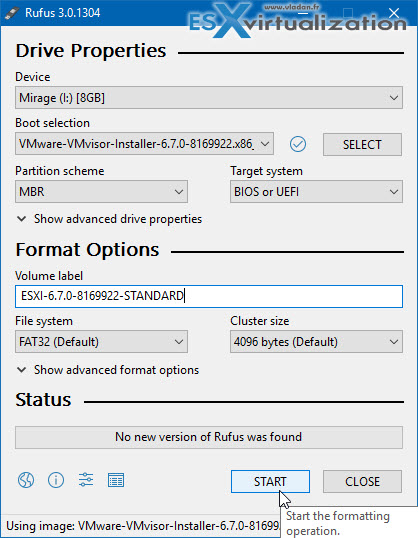

- #Rufus usb installer for mac how to#
- #Rufus usb installer for mac install#
- #Rufus usb installer for mac windows 10#
- #Rufus usb installer for mac pro#
Make sure the destination disk is the USB thumb drive you've inserted.Ĭlick Continue. Click the "Choose…" button and locate the ISO file.
#Rufus usb installer for mac install#
#Rufus usb installer for mac windows 10#
There are some links on the site for some helpful tutorials on creating certain types of UFDs, and there’s multiple localization support for a variety of languages worldwide.Download Windows 10 ISO Create USB installer with Boot Camp AssistantĪfter downloading the ISO file, you'll need to use Boot Camp Assistant to move it to a bootable USB drive. The days of carrying multiple CD/DVDs with you and dealing with lagging installs are drawing to a close with the ubiquitous use of USB drives–and the storage capacity can’t be beat. With the process completed, simply eject the UFD, insert it into the device you wish to install the OS on, and boot as you normally would. When complete, double-check the external drive to verify the files were copied over ( Figure F).This is typically the last step and varies depending on file size/number of files to copy ( Figure E). The longest part of the entire process is the file copy portion.For the log readout of each step in the process, click the Log button to open a side window and save the output details ( Figure D). Depending on the ISO image size, the process may take several minutes to complete.Click OK to proceed with the creation process ( Figure C). You’ll be prompted with a warning that all data on the UFD will be destroyed. Once everything is set correctly, click the Start button to begin the process. When using ISO images, Rufus will automatically modify the settings to best match it.Click the optical drive button next to the Create a bootable disk using checkbox, and you’ll be prompted to search for the ISO image to use ( Figure B).Since Rufus can handle various partition schemes and file structures, ensure that the correct settings are set that match the UFD you’re going to build ( Figure A). It will detect the drive almost immediately. After authenticating, insert the USB flash drive and launch Rufus. Rufus requires an account with admin access in order to make the necessary changes to hardware.Now, let’s create our first bootable UFD using Rufus, shall we? Follow these steps: 8 GB USB flash drive (minimum recommended).

Apple (or PC) running Windows XP or later (preferably Windows 7+).With that out of the way, let’s look at the requirements for Rufus:
#Rufus usb installer for mac pro#
See: Don’t just toss old flash drives, download our Media disposal policy (Tech Pro Research) Rufus system requirements Simply put, one machine can handle many different uses, as opposed to purchasing dedicated equipment for each supported OS type. Apple hardware supports these operating systems natively, making Macs a versatile choice for production equipment. Macs, on the other hand, have the ability to run Windows and countless Linux distributions alongside OS X or in place of it. The answer to that is quite simply “because you can.” Apple hardware is similar to its PC counterparts in many ways except one: PCs can’t natively run OS X without any software hacks involved. Why would you install any OS–besides OS X–on an Apple computer? But before diving into that, I have a question of my own.
#Rufus usb installer for mac how to#
After last week’s article, ” Pro tip: How to create a bootable USB drive to install Windows on OS X,” I received feedback asking why anyone would install Windows on a Mac? This week’s entry deals with creating UFDs that allow you to install many other operating systems with the help of a utility called Rufus.


 0 kommentar(er)
0 kommentar(er)
